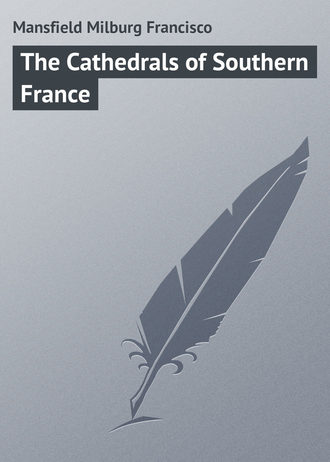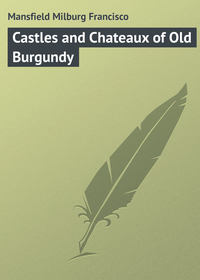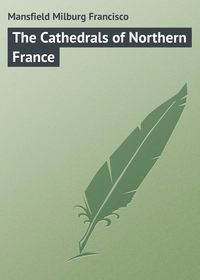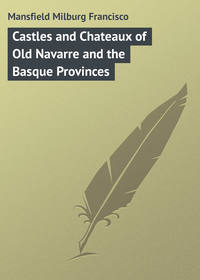 полная версия
полная версияThe Cathedrals of Southern France
In ancient Gallic records its cathedral was reckoned as some miles from the present site of the town, but as no other remains than those of St. Théodorit are known to-day, it is improbable that any references in mediæval history refer to another structure.
This church is now no longer a cathedral, the see having been suppressed in 1790.
The bishop here, as at Lodève and Mende, was the count of the town, and the bishop and duke each possessed their castles and had their respective spheres of jurisdiction, which, says an old-time chronicler, "often occasioned many disputes." Obviously!
In the sixteenth century most of the inhabitants embraced the Reformation after the example of their bishop, who, with all his chapter, publicly turned Protestant and "sent for a minister to Geneva."
What remains of the cathedral to-day is reminiscent of a highly interesting mediæval foundation, though its general aspect is distinctly modern. Such rebuilding and restoration as it underwent, in the seventeenth and eighteenth centuries, made of it practically a new edifice.
The one feature of mark, which stands alone as the representative of mediæval times, is the charming tower which flanks the main body of the church on the right.
It is known as the "Tour Fenestrelle" and is of the thirteenth century. It would be a notable accessory to any great church, and is of seven stories in height, each dwindling in size from the one below, forming a veritable campanile. Its height is 130 feet.
The interior attractions of this minor church are greater than might be supposed. There is a low gallery with a superb series of wrought-iron grilles, a fine tomb in marble – to Bishop Boyan – and in the transept two paintings by Simon de Chalons – a "Resurrection" and a "Raising of Lazarus."
The inevitable obtrusive organ-case is of the seventeenth century, and like all of its kind is a parasitical abomination, clinging precariously to the western wall.
The sacristy is an extensive suite of rooms which contain throughout a deep-toned and mellow oaken wainscot.
For the rest, the lines of this church follow the conventionality of its time. Its proportions, while not great, are good, and there is no marked luxuriance of ornament or any exceeding grace in the entire structure, if we except the detached tower before mentioned.
The situation of the town is most picturesque; not daintily pretty, but of a certain dignified order, which is the more satisfying.
The ancient château, called Le Duché, is the real architectural treat of the place.
XVI
ST. JEAN D'ALAIS
Alais is an ancient city, but greatly modernized; moreover it does not take a supreme rank as a cathedral city, from the fact that it held a bishop's throne for but a hundred years. Alais was a bishopric only from 1694 to 1790.
The cathedral of St. Jean is an imposing structure of that obtrusive variety of architectural art known as "Louis Quinze," and is unworthy of the distinction once bestowed upon it.
Perhaps it is due to the fact that the Cevenole country was so largely and aggressively Protestant that the see of Alais did not endure. Robert Louis Stevenson tells of a stranger he met in these mountain parts – that he was a Catholic, "and made no shame of it. No shame of it! The phrase is a piece of natural statistics; for it is the language of one of a minority… Ireland is still Catholic; the Cevennes still Protestant. Outdoor rustics have not many ideas, but such as they have are hardy plants and thrive flourishingly in persecution."
Built about in the façade of this unfeeling structure are some remains of a twelfth-century church, but they are not of sufficient bulk or excellence to warrant remark.
An advancing porch stands before this west façade and is surmounted by a massive tower in a poor Gothic style.
The vast interior, like the exterior, is entirely without distinction, though gaudily decorated. There are some good pictures, which, as works of art, are a decided advance over any other attributes of this church – an "Assumption," attributed to Mignard, in the chapel of the Virgin; in the left transept, a "Virgin" by Deveria; and in the right transept an "Annunciation" by Jalabert.
Alais is by no means a dull place. It is busy with industry, is prosperous, and possesses on a minute scale all the distractions of a great city. It is modern to the very core, so far as appearances go. It has its Boulevard Victor Hugo, its Boulevard Gambetta, and its Lycée Dumas. The Hôpital St. Louis – which has a curious doubly twisted staircase – is of the eighteenth century; a bust of the Marquis de la Fère-Alais, the Cevenole poet, is of the nineteenth; a monument of bronze, to the glory of Pasteur, dates from 1896; and various other bronze and stone memorials about the city all date and perpetuate the name and fame of eighteenth and nineteenth-century notables.
The Musée – another recent creation – occupies the former episcopal residence, of eighteenth-century construction.
The Hôtel de Ville is quite the most charming building of the city. It has fine halls and corridors, and an ample bibliothèque. Its present-day Salle du Conseil was the ancient chamber of the États du Languedoc.
XVII
ST. PIERRE D'ANNECY
The Savoian city of Annecy was formerly the ancient capital of the Genevois.
Its past history is more closely allied with other political events than those which emanated from within the kingdom of France; and its ecclesiastical allegiance was intimately related with Geneva, from whence the episcopal seat was removed in 1535.
In reality the Christian activities of Annecy had but little to do with the Church in France, Savoie only having been ceded to France in 1860. Formerly it belonged to the ducs de Savoie and the kings of Sardinia.
Annecy is a most interesting city, and possesses many, if not quite all, of the attractions of Geneva itself, including the Lake of Annecy, which is quite as romantically picturesque as Lac Leman, though its proportions are not nearly so great.
The city's interest for the lover of religious associations is perhaps greater than for the lover of church architecture alone, but, as the two must perforce go hand in hand the greater part of the way, Annecy will be found to rank high in the annals of the history and art of the religious life of the past.
In the chapel of the Visitation, belonging to the convent of the same name, are buried St. François de Sales (d. 1622) and Ste. Jeanne de Chantal (d. 1641). The chapel is architecturally of no importance, but the marble ornament and sculptures and the rich paintings are interesting.
The ancient chapel of the Visitation – the convent of the first monastery founded by St. Francis and Ste. Jeanne – immediately adjoins the cathedral.
Christianity first came to Annecy in the fourth century, with St. Emilien. For long after its foundation the see was a suffragan of the ancient ecclesiastical province of Vienne. To-day it is a suffragan of Chambéry.
The rather ordinary cathedral of St. Pierre has no great interest as an architectural type, and is possessed of no embellishments of a rank sufficiently high to warrant remark. It dates only from the sixteenth century, and is quite unconvincing as to any art expression which its builders may have possessed.
The episcopal palace (1784) adjoins the cathedral on the south.
XVIII
CATHÉDRALE DE CHAMBÉRY
The city of Chambéry in the eighteenth century must have been a veritable hotbed of aristocracy. A French writer of that day has indeed stated that it is "the winter residence of all the aristocracy of Savoie; … with twenty thousand francs one could live en grand seigneur; … a country gentleman, with an income of a hundred and twenty louis d'or a year, would as a matter of course take up his abode in the town for the winter."
To-day such a basis upon which to make an estimate of the value of Chambéry as a place of residence would be, it is to be feared, misleading.
Arthur Young closes his observations upon the agricultural prospects of Savoie with the bold statement that: "On this day, left Chambéry much dissatisfied, – for the want of knowing more of it."
Rousseau knew it better, much better. "S'il est une petite ville au monde où l'on goûte la douceur de la vie dans un commerce agréable et sûr, c'est Chambéry."
Savoie and the Comté de Nice were annexed to France only as late as 1860, and from them were formed the departments of Savoie, Haute-Savoie, and the Alpes-Maritimes.
Chambéry is to-day an archbishopric, with suffragans at Annecy, Tarentaise, and St. Jean de Maurienne. Formerly conditions were reversed, and Chambéry was merely a bishopric in the province de Tarentaise. Its first bishop, Michel Conseil, came in office, however, only in 1780.
The cathedral is of the fourteenth century, in the pointed style, and as a work of art is distinctly of a minor class.
The principal detail of note is a western portal which somewhat approaches good Gothic, but in the main, both inside and out, the church has no remarkable features, if we except some modern glass, which is better in colour than most late work of its kind.
As if to counteract any additional charm which this glass might otherwise lend to the interior, we find a series of flamboyant traceries over the major portion of the side walls and vaulting. These are garish and in every way unpleasing, and the interior effect, like that of the exterior, places the cathedral at Chambéry far down the scale among great churches.
Decidedly the architectural embellishments of Chambéry lie not in its cathedral.
The chapel of the ancient château, dating in part from the thirteenth century, but mainly of the Gothic-Renaissance period, is far and away the most splendid architectural monument of its class to be seen here.
La Grande Chartreuse is equally accessible from either Chambéry or Grenoble, and should not be neglected when one is attempting to familiarize himself with these parts.
XIX
NOTRE DAME DE GRENOBLE
It is an open question as to whether Grenoble is not possessed of the most admirable and impressive situation of any cathedral city of France.
At all events it has the attribute of a unique background in the massif de la Chartreuse, and the range of snow-clad Alps, which rise so abruptly as to directly screen and shelter the city from all other parts lying north and east. Furthermore this natural windbreak, coupled with the altitude of the city itself, makes for a bright and sunny, and withal bracing, atmosphere which many professed tourist and health resorts lack.
Grenoble is in all respects "a most pleasant city," and one which contains much of interest for all sorts and conditions of pilgrims.
Anciently Grenoble was a bishopric in the diocese of the Province of Vienne, to whose archbishop the see was at that time subordinate. Its foundation was during the third century, and its first prelate was one Domninus.
In the redistribution of dioceses Grenoble became a suffragan of Lyon et Vienne, which is its status to-day.
As might naturally be inferred, in the case of so old a foundation, its present-day cathedral of Notre Dame partakes also of early origin.
This it does, to a small degree only, with respect to certain of the foundations of the choir. These date from the eleventh century, while succeeding eras, of a mixed and none too pure an architectural style, culminate in presenting a singularly unconvincing and cold church edifice.
The "pointed" tabernacle, which is the chief interior feature, is of the middle fifteenth century, and indeed the general effect is that of the late Middle Ages, if not actually suggestive of still later modernity.
The tomb of Archbishop Chissé, dating from 1407, is the cathedral's chief monumental shrine.
To the left of the cathedral is the ancient bishop's palace; still used as such. It occupies the site of an eleventh-century episcopal residence, but the structure itself is probably not earlier than the fifteenth century.
In the Église de St. André, a thirteenth-century structure, is a tomb of more than usual sentimental and historical interest: that of Bayard. It will be found in the transept.
No mention of Grenoble could well ignore the famous monastery of La Grande Chartreuse.
Mostly, it is to be feared, the monastery is associated in mundane minds with that subtle and luxurious liqueur which has been brewed by the white-robed monks of St. Bruno for ages past; and was until quite recently, when the establishment was broken up by government decree and the real formula of this sparkling liqueur departed with the migrating monks.
The opinion is ventured, however, that up to the time of their expulsion (in 1902), the monks of St. Bruno combined solitude, austerity, devotion, and charity of a most practical kind with a lucrative commerce in their distilled product after a successful manner not equalled by any religious community before or since.
The Order of St. Bruno has weathered many storms, and, during the Terror, was driven from its home and dispersed by brutal and riotous soldiery. In 1816 a remnant returned, escorted, it is said, by a throng of fifty thousand people.
The cardinal rule of the Carthusians is abstemiousness from all meat-eating; which, however, in consideration of their calm, regular life, and a diet in which fish plays an important part, is apparently conducive to that longevity which most of us desire.
It is related that a certain Dominican pope wished to diminish the severity of St. Bruno's regulations, but was met by a delegation of Carthusians, whose doyen owned to one hundred and twenty years, and whose youngest member was of the ripe age of ninety. The amiable pontiff, not having, apparently, an argument left, accordingly withdrew his edict.
Of all these great Charterhouses spread throughout France, La Grande Chartreuse was the most inspiring and interesting; not only from the structure itself, but by reason of its commanding and romantic situation amid the forest-clad heights of the Savoyan Alps.
The first establishment here was the foundation of St. Bruno (in 1084), which consisted merely of a modest chapel and a number of isolated cubicles.
This foundation only gave way – as late as the sixteenth and seventeenth centuries – to an enlarged structure more in accord with the demands and usage of this period.
The most distinctive feature of its architecture is the grand cloister, with its hundred and fifteen Gothic arches, out of which open the sixty cells of the sandalled and hooded white-robed monks, who, continuing St. Bruno's regulation, live still in isolation. In these cells they spent all of their time outside the hours of work and worship, but were allowed the privilege of receiving one colleague at a time. Here, too, they ate their meals, with the exception of the principal meal on Sundays, when they all met together in the refectory.
The Église de la Grande Chartreuse itself is very simple, about the only distinctive or notable feature being the sixteenth-century choir-stalls. At the midnight service, or at matins, when the simple church is lit only by flaming torches, and the stalls filled with white-robed Chartreux, is presented a picture which for solemnity and impressiveness is as vivid as any which has come down from mediæval times.
The chanting of the chorals, too, is unlike anything heard before; it has indeed been called, before now, angelic. Petrarch, whose brother was a member of the order, has put himself on record as having been enchanted by it.
As many as ten thousand visitors have passed through the portals of La Grande Chartreuse during the year, but now in the absence of the monks – temporary or permanent as is yet to be determined – conditions obtain which will not allow of entrance to the conventual buildings.
No one, however, who visits either Grenoble or Chambéry should fail to journey to St. Laurent du Pont – the gateway of the fastness which enfolds La Grande Chartreuse, and thence to beneath the shadow of the walls which for so long sheltered the parent house of this ancient and powerful order.
XX
BELLEY AND AOSTE
En route to Chambéry, from Lyon, one passes the little town of Belley. It is an ancient place, most charmingly situated, and is a suffragan bishopric, strangely enough, of Besançon, which is not only Teutonic in its tendencies, but is actually of the north.
At all events, Belley, in spite of its clear and crisp mountain air, is not of the same climatic zone as the other dioceses in the archbishopric of Besançon.
Its cathedral is distinctly minor as to style, and is mainly Gothic of the fifteenth century; though not unmixed, nor even consistent, in its various parts. No inconsiderable portion is modern, as will be plainly seen.
One distinctly notable feature is a series of Romanesque columns in the nave, possibly taken from some pagan Roman structure. They are sufficiently of importance and value to be classed as "Monuments Historiques," and as such are interesting.
Aoste (Aoste-St. – Genix) is on the site of the Roman colony of Augustum, of which to-day there are but a few fragmentary remains. It is perhaps a little more than a mile from the village of St. Genix, with which to-day its name is invariably coupled. As an ancient bishopric in the province of Tarentaise, it took form in the fourth century, with St. Eustache as its first bishop. To-day the ecclesiastical jurisdiction of all this region – the Val-de-Tarentaise – is held by Tarentaise.
XXI
ST. JEAN DE MAURIENNE
St. Jean de Maurienne is a tiny mountain city well within the advance-guard of the Alpine range. Of itself it savours no more of the picturesque than do the immediate surroundings. One can well understand that vegetation round about has grown scant merely because of the dearth of fructifying soil. The valleys and the ravines flourish, but the enfolding walls of rock are bare and sterile.
This is the somewhat abbreviated description of the pagi garnered from an ancient source, and is, in the main, true enough to-day.
Not many casual travellers ever get to this mountain city of the Alps; they are mostly rushed through to Italy, and do not stop short of the frontier station of Modane, some thirty odd kilometres onward; from which point onward only do they know the "lie of the land" between Paris and Piedmont.
St. Jean de Maurienne is to-day, though a suffragan of Chambéry, a bishopric in the old ecclesiastical province of Tarentaise. The first archbishop – as the dignity was then – was St. Jacques, in the fifth century.
The cathedral of St. Jean is of a peculiar architectural style, locally known as "Chartreusian." It is by no means beautiful, but it is not unpleasing. It dates, as to the epoch of its distinctive style, from the twelfth to the fifteenth centuries, though it has been so fully restored in our day that it may as well be considered as a rebuilt structure, in spite of the consistent devotion to the original plan.
The chief features of note are to be seen in its interior, and, while they are perhaps not of extraordinary value or beauty, in any single instance, they form, as a whole, a highly interesting disposition of devout symbols.
Immediately within the portico, by which one enters from the west, is a plaster model of the tomb of Count Humbert, the head of the house of Savoie.
In the nave is an altar and mausoleum in marble, gold, and mosaic, erected by the Carthusians to St. Ayrald, a former bishop of the diocese and a member of their order.
In the left aisle of the nave is a tomb to Oger de Conflans, and another to two former bishops.
Through the sacristy, which is behind the chapel of the Sacred Heart, is the entrance to the cloister. This cloister, while not of ranking greatness or beauty, is carried out, in the most part, in the true pointed style of its era (1452), and is, on the whole, the most charming attribute of the cathedral.
The choir has a series of carved stalls in wood, which are unusually acceptable. In the choir, also, is a ciborium, in alabaster, with a reliquaire which is said to contain three fingers of John the Baptist, brought to Savoie in the sixth century by Ste. Thècle.
The crypt, beneath the choir, is, as is most frequently the case, the remains of a still earlier church, which occupied the same site, but of which there is little record extant.
XXII
ST. PIERRE DE ST. CLAUDE
St. Claude is charmingly situated in a romantic valley of the Jura.
The sound of mill-wheels and the sight of factory chimneys mingle inextricably with the roaring of mountain torrents and the solitude of the pine forest.
The majority of the inhabitants of these valleys lead a simple and pastoral life, with cheese-making apparently the predominant industry. Manufacturing of all kinds is carried on, in a small way, in nearly every hamlet – in tiny cottage ateliers– wood-carving, gem-polishing, spectacle and clock-making, besides turnery and wood-working of all sorts.
St. Claude, with its ancient cathedral of St. Pierre, is the centre of all these activities; which must suggest to all publicists of time-worn and ennuied lands a deal of possibilities in the further application of such industrial energies as lie close at hand.
In 1789, when Arthur Young, in his third journey through France, passed through St. Claude, the count-bishop of the diocese, the sole inheritor of its wealthy abbey foundation and all its seigneurial dependencies, had only just enfranchised his forty thousand serfs.
Voltaire, the atheist, pleaded in vain the cause of this Christian prelate, and for him to be allowed to sustain his right to bond-men; but opposition was too great, and they became free to enjoy property rights, could they but once acquire them. Previously, if childless, they had no power to bequeath their property; it reverted simply to the seigneur by custom of tradition.
In the fifth century, St. Claude was the site of a powerful abbey. It did not become an episcopal see, however, until 1742, when its first bishop was Joseph de Madet.
At the Revolution the see was suppressed, but it rose again, phoenix-like, in 1821, and endures to-day as a suffragan of Lyon et Vienne.
The cathedral of St. Pierre is a fourteenth-century edifice, with later work (seventeenth century) equally to be remarked. As a work of restoration it appears poorly done, but the entire structure is of more than ordinary interest; nevertheless it still remains an uncompleted work.
The church is of exceedingly moderate dimensions, and is in no sense a great achievement. Its length cannot be much over two hundred feet, and its width and height are approximately equal (85 feet), producing a symmetry which is too conventional to be really lovable.
Still, considering its environment and the association as the old abbey church, to which St. Claude, the bishop of Besançon, retired in the twelfth century, it has far more to offer in the way of a pleasing prospect than many cathedrals of greater architectural worth.
There are, in its interior, a series of fine choir-stalls in wood, of the fifteenth century – comparable only with those at Rodez and Albi for their excellence and the luxuriance of their carving – a sculptured Renaissance retable depicting the life of St. Pierre, and a modern high-altar. This last accessory is not as worthy an art work as the two others.
XXIII
NOTRE DAME DE BOURG
The chief ecclesiastical attraction of Bourg-en-Bresse is not its one-time cathedral of Notre Dame, which is but a poor Renaissance affair of the fifteenth to seventeenth centuries.
The famous Église de Brou, which Matthew Arnold described so justly and fully in his verses, is a florid Gothic monument which ranks among the most celebrated in France. It is situated something less than a mile from the town, and is a show-piece which will not be neglected. Its charms are too many and varied to be even suggested here.
There are a series of sculptured figures of the prophets and apostles, from a fifteenth or sixteenth-century atelier, that may or may not have given the latter-day Sargent his suggestion for his celebrated "frieze of the prophets." They are wonderfully like, at all events, and the observation is advisedly included here, though it is not intended as a sneer at Sargent's masterwork.









